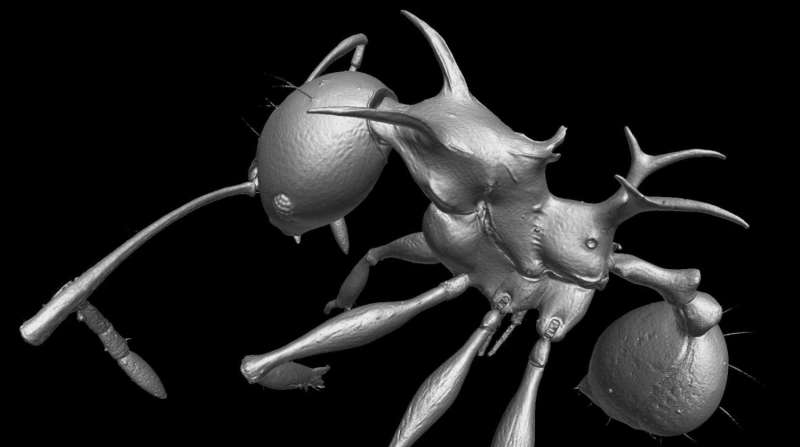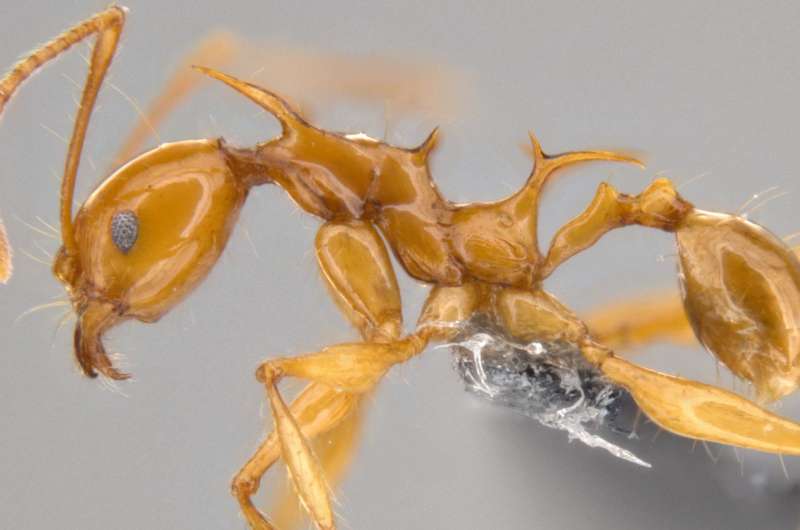Two new highly adorned spiky ant species discovered in New Guinea

The distinctive dorsal spines found on two new species of highly adorned Pheidole ants may help to support the ants' massive heads, according to a study published July 27, 2016 in the open-access journal PLOS ONE by Eli Sarnat, Georg Fischer and Evan Economo from the Okinawa Institute of Science & Technology Graduate University, Japan.
The Pheidole genus is hyperdiverse, containing over 1000 species spread throughout the globe. The genus has the common name of 'big headed ants,' as Pheidole soldier ants usually have enormous heads and jaws to break up large food items. The authors of the present study incorporated phylogenetic results and a cutting edge 3D imaging technique known as X-ray microtomography (micro-CT) to identify and model ants in the Pheidole cervicornis group found in the tropical rainforests of New Guinea.
"This is one of the first studies in ant taxonomy to use micro-CT," said Evan Economo. "While this method is gaining popularity in different scientific fields, it is rare to use it in this way."
Amongst the ants, the authors discovered two new, highly adorned, dragon-like species, Pheidole viserion and Pheidole drogon, with distinctive large spines protruding from their dorsal plates. Scientists previously assumed that the spiky appearance of certain ant species was a defense mechanism. However, the authors used micro-CT to reveal that in soldier ants of these new species, neck spines contain muscle fibers. Although more research is needed, they suggest that muscles in the spines may help these ants to hold up their massive heads.

The species names Pheidole viserion and Pheidole drogon were inspired by the dragon-like appearance of the ants, which are named after dragons in the fantasy books and television series 'Game of Thrones.'
"Once you open up the rotational 3D PDF and see these ants' extraordinary spines, or "inordinate spinescence" as we phrase it in the study, you can't help but ask why on earth these structures evolved," said Eli Sarnat. "The most obvious answer is defense, but the internal morphology revealed by this new micro-CT scanning technology suggests that the answer might also have something to do with muscle mechanics and powering the huge heads of the soldier ants."
In a related study also published July 27, 2016 in the open-access journal PLOS ONE the authors describe two additional new species of ants from the Pheidole knowlesi species group found in the Fijian Islands. In contrast to their highly adorned New Guinean relatives, Pheidole ululevu and Pheidole kava have a much less dramatic appearance, and were named after their large head and a mildly narcotic drink from the Pacific Islands, respectively.
More information: Sarnat EM, Fischer G, Economo EP (2016) Inordinate Spinescence: Taxonomic Revision and Microtomography of the Pheidole cervicornis Species Group (Hymenoptera, Formicidae). PLoS ONE 11(7): e0156709. DOI: 10.1371/journal.pone.0156709
Journal information: PLoS ONE
Provided by Public Library of Science





















